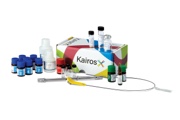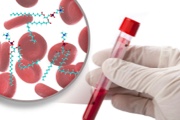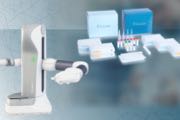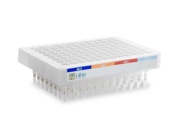Metabolomics
Name
Published by

This example method provides a freely adjustable framework for measuring the adaptability of the OneLab environment to workflows from different application fields. It helps to understand various nuances of the code-free, universal protocol designer and provides general indications as to the feasibility of a project. Scripts generally require fine adjustment to correct for variables and support specific labware implementation.
Investigating the ACE inhibitory activity of active biomolecules is a valuable source of drugs for the treatment of cardiovascular diseases.
OneLab helps mitigate the effects of pipetting errors and variability during the assessment of ACE inhibition and IC50 determination. This allows for the delivery of more reliable and accurate data, while eventually accelerating biological discovery.

This basic method provides the core methodology for translating a workflow into OneLab-executable script(s) as an attempt to fully or semi-automate a specific procedure. It demonstrates the benefits of automation and highlights OneLab capabilities and best practices to promote solution adoption, helping transition from manual to a more automated approach. It can be used alone or serves as a building block for a more complex workflow and is easily adaptable to users' requirements.
To analyze amino acids in biological samples by LC-MS, Waters provides a fast reproducible solution that uses pre-column derivatization built on the AccQ•Tag reaction chemistry, with the ability to quantitate over 40 amino acids in less than 10 minutes.
Waters Kairos Amino Acid Kit – High Throughput (500+) enables precise and accurate preparation of over 40 amino acids using the Andrew+ Pipetting Robot.

This basic method provides the core methodology for translating a workflow into OneLab-executable script(s) as an attempt to fully or semi-automate a specific procedure. It demonstrates the benefits of automation and highlights OneLab capabilities and best practices to promote solution adoption, helping transition from manual to a more automated approach. It can be used alone or serves as a building block for a more complex workflow and is easily adaptable to users' requirements.
Lipids are important molecules involved in energy metabolism, signaling, and membrane formation. They are pivotal in understanding disease and its progression.
Here we highlight an automated MTBE liquid-liquid extraction method of lipids and small molecules from biological matrices. The automated method helps streamline this multi-step extraction protocol saving time and reducing operator errors.

This advanced method offers an end-to-end solution developed around an advanced application, a specialized kit, or an analytical system. It delivers complete functional, ready-to-use protocols that are qualitatively and quantitatively assessed for consistency, executability, and repeatability, usually without needing to make any changes. It operates per batch size and is scalable to accommodate changing requirements.
The MxP® Quant 500 is a comprehensive, ready-to-use kit crafted for precise quantitative metabolic profiling and rigorously quality-controlled to ensure optimal performance.
Leveraging the Andrew+ pipetting system and the corresponding OneLab protocol enhances throughput, reduces personnel involvement, and increases reproducibility, making it ideally suited for extensive large-scale studies.

This basic method provides the core methodology for translating a workflow into OneLab-executable script(s) as an attempt to fully or semi-automate a specific procedure. It demonstrates the benefits of automation and highlights OneLab capabilities and best practices to promote solution adoption, helping transition from manual to a more automated approach. It can be used alone or serves as a building block for a more complex workflow and is easily adaptable to users' requirements.
Mixed-mode SPE is a sample clean-up technique for LC-MS analysis. Selecting a mixed-mode SPE sorbent can be challenging, requiring a good understanding of the sorbent/analyte chemistry. In addition, it involves accurate and precise pipetting steps.
This protocol demonstrates a rapid and robust Andrew+ automated mixed-mode SPE sorbent selection method using the Oasis 2x4 sorbent selection plate.
